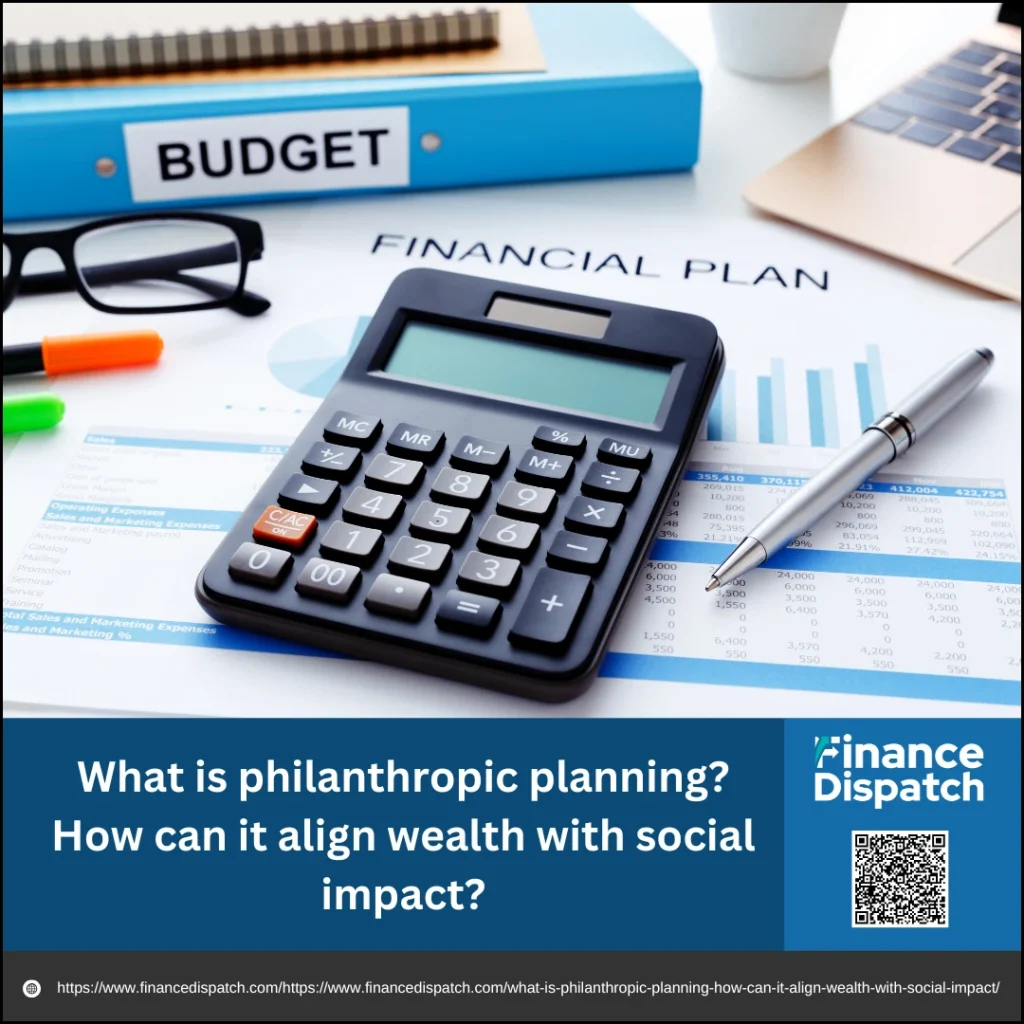In an age where wealth is increasingly seen as a tool for positive transformation, philanthropic planning has emerged as a meaningful bridge between financial success and social responsibility. More than just generous donations, it’s a deliberate strategy that allows individuals and families to align their financial resources with the causes they care about most. Whether it’s through establishing a charitable trust, funding community programs, or supporting global initiatives, philanthropic planning offers a powerful way to give with intention. It empowers you to not only manage your wealth wisely but also create a legacy that reflects your values and contributes to lasting impact.
What is Philanthropic Planning?
Philanthropic planning is the thoughtful process of aligning your charitable giving with your personal values, financial goals, and desired social impact. Rather than making occasional donations, it involves creating a strategic framework that guides how, when, and where you give. This might include identifying specific causes you care about, choosing the most effective giving vehicles—such as donor-advised funds, private foundations, or charitable trusts—and ensuring that your contributions are sustainable and tax-efficient. At its core, philanthropic planning is about making a meaningful difference in the world while managing your resources in a way that supports both your legacy and the well-being of others.
Why Philanthropic Planning Matters Today
In today’s rapidly changing world, the need for strategic and impactful giving has never been greater. Social, environmental, and economic challenges continue to grow in complexity, requiring more than just spontaneous acts of generosity. Philanthropic planning offers a way to respond with intention, ensuring that your contributions support long-term solutions rather than short-term relief. It empowers individuals, families, and organizations to make informed decisions, measure their impact, and align their financial resources with the values they hold dear. As wealth grows and global awareness increases, philanthropic planning becomes a vital tool for those who want to be purposeful in their giving and create a legacy that truly matters.
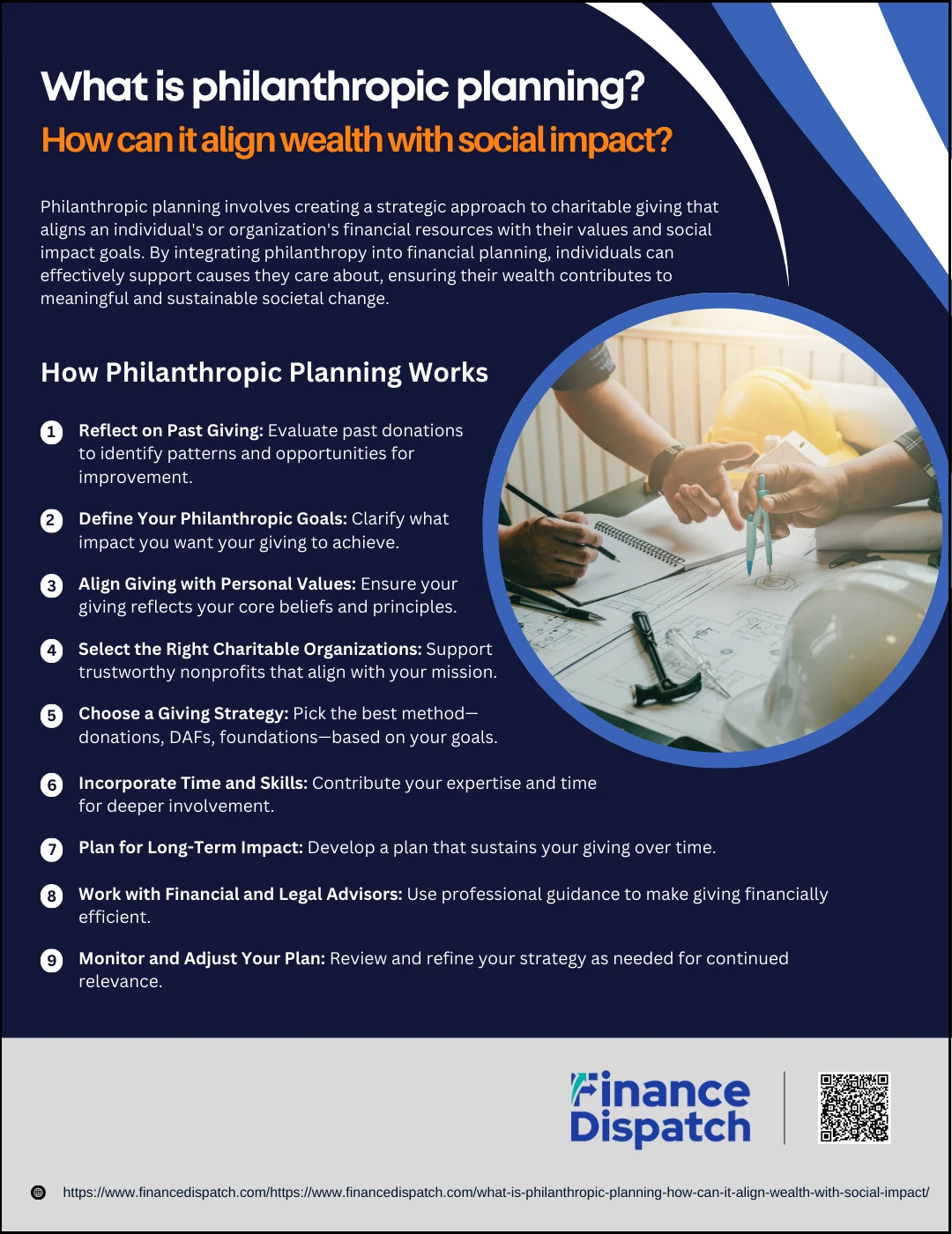 How Philanthropic Planning Works
How Philanthropic Planning Works
Philanthropic planning is a guided, intentional process that transforms charitable giving from a series of disconnected donations into a powerful strategy for long-term impact. It helps you channel your wealth toward the causes you care about in a way that is both emotionally fulfilling and financially efficient. Instead of reacting to donation requests or trending issues, philanthropic planning allows you to proactively support change by aligning your resources, values, and legacy goals. Here’s how the process typically unfolds:
1. Reflect on Past Giving
Start by looking back at your previous charitable contributions. What causes have you supported? Were they consistent with your values? Did those donations create the kind of impact you hoped for? This reflection helps you understand your patterns and identify any gaps or opportunities.
2. Define Your Philanthropic Goals
Clarify what you want to achieve through your giving. Is your aim to empower underprivileged communities, improve healthcare, fund education, or protect the environment? Well-defined goals serve as a compass for all your future charitable decisions.
3. Align Giving with Personal Values
Think about what matters most to you or your family. When your philanthropic goals are rooted in your core beliefs, your giving becomes more meaningful, intentional, and sustainable over time.
4. Select the Right Charitable Organizations
Research potential nonprofits, foundations, or initiatives that align with your mission. Look for those with a solid track record, transparent operations, and measurable impact. Choosing the right partners is crucial to making your vision a reality.
5. Choose a Giving Strategy
Decide how you want to give. This could be through one-time direct donations, ongoing support via donor-advised funds, or establishing a private foundation for greater control and legacy-building. The right vehicle depends on your financial capacity, desired involvement, and long-term objectives.
6. Incorporate Time and Skills
Your expertise and time can be just as valuable as money. Consider volunteering, mentoring, or serving on nonprofit boards. These contributions strengthen your connection to the cause and offer hands-on insight into the real-world impact of your giving.
7. Plan for Long-Term Impact
Philanthropic planning isn’t just about immediate results. Create a multi-year giving plan, set up an endowment, or establish a legacy fund to ensure your impact continues for generations. Long-term thinking increases sustainability and deepens your contribution.
8. Work with Financial and Legal Advisors
Collaborate with professionals to structure your giving in the most tax-efficient and legally sound way. Advisors can help you assess risk, optimize deductions, and integrate philanthropy into your broader wealth or estate plan.
9. Monitor and Adjust Your Plan
Philanthropic goals and societal needs can evolve. Regularly review your giving strategy, measure outcomes, and adjust your approach if needed. Staying flexible ensures your plan remains relevant and effective over time.
Key Elements of an Effective Philanthropic Plan
Creating a meaningful philanthropic plan goes beyond choosing a charity and writing a check. It involves thoughtful preparation, strategic decision-making, and a deep understanding of your personal values and goals. An effective plan serves as a roadmap for giving, helping you stay focused, organized, and impactful in your charitable efforts. Whether you’re donating time, money, or expertise, these key elements form the foundation of a successful philanthropic journey:
1. Clear Mission and Values: Define what causes matter most to you and why. A clear mission ensures your giving is purposeful and reflects your core beliefs.
2. Specific Goals: Set measurable short- and long-term objectives. This could include the number of people you want to help, the type of programs you want to support, or the geographic areas you want to impact.
3. Budget and Financial Strategy: Determine how much you can give and when. Include your philanthropic contributions in your financial planning to ensure they’re sustainable and tax-efficient.
4. Chosen Giving Vehicles: Decide which methods best suit your goals—such as donor-advised funds, charitable trusts, private foundations, or direct donations.
5. Selection Criteria for Charities: Establish guidelines for evaluating and choosing nonprofit organizations, based on impact, transparency, and alignment with your mission.
6. Involvement Strategy: Define how involved you want to be beyond financial contributions. Will you volunteer, serve on boards, or offer professional expertise?
7. Evaluation and Impact Measurement: Track the outcomes of your giving. Use reports, feedback, or site visits to assess whether your support is making a difference.
8. Flexibility and Review Process: A good plan allows room for change. Regularly revisit your goals, budgets, and strategies to stay aligned with evolving priorities and emerging needs.
9. Family or Successor Engagement: Consider how to involve your family or designate future leaders to carry on your philanthropic vision for the long term.
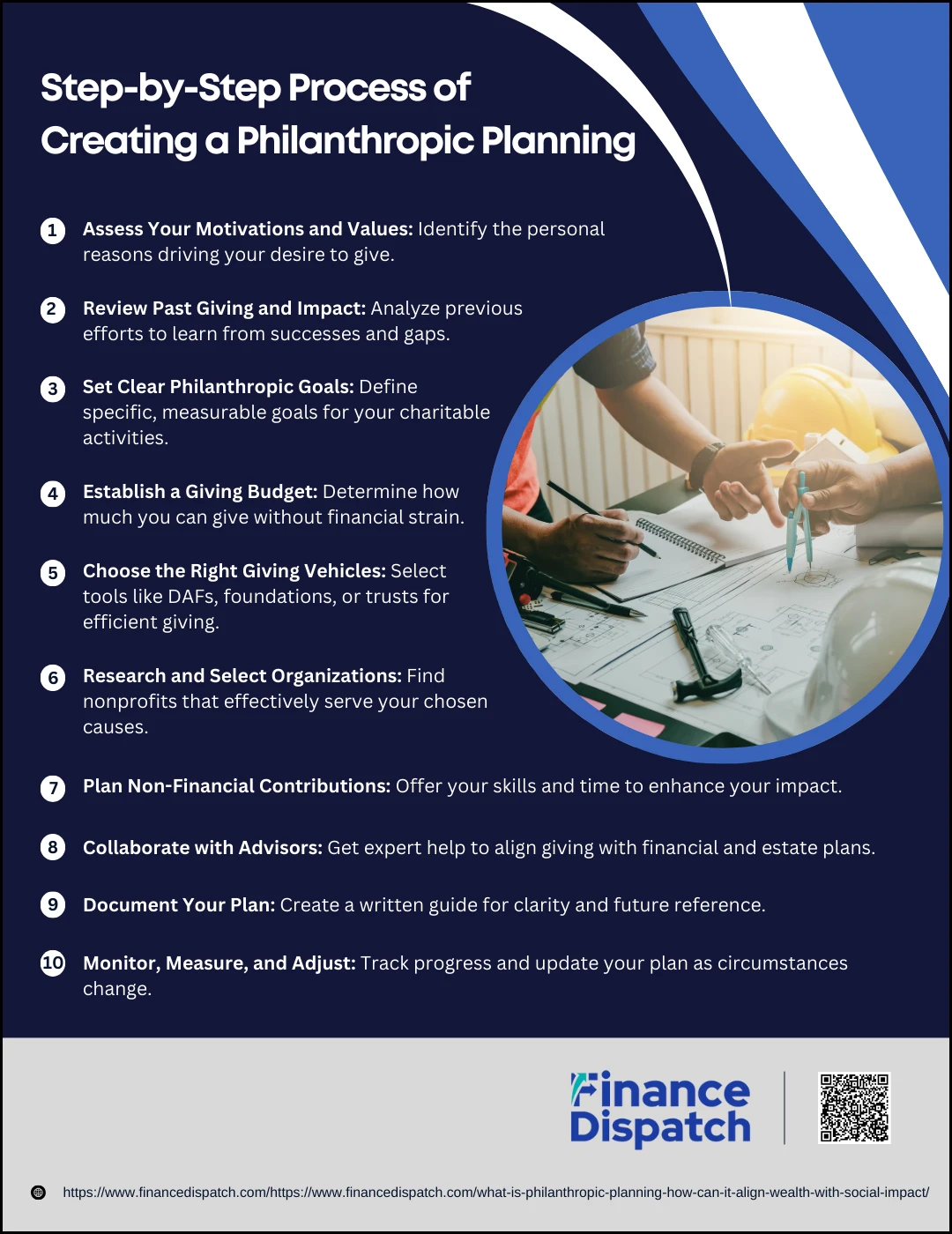 Step-by-Step Process of Creating a Philanthropic Planning
Step-by-Step Process of Creating a Philanthropic Planning
Philanthropy becomes most impactful when approached with the same care and intention as any other major life or financial decision. A structured plan allows you to give with clarity, stay aligned with your personal mission, and ensure your contributions drive lasting change. Whether you’re donating time, money, or expertise, this step-by-step process helps you move from inspiration to action while making the most of your resources.
1. Assess Your Motivations and Values
Begin by asking yourself why you want to give. Is it to honor a personal experience, address a social injustice, or support a specific community? Understanding your motivation will help clarify your “why” and guide all future giving decisions. This step sets the emotional and philosophical foundation of your plan.
2. Review Past Giving and Impact
Reflect on your previous charitable efforts. Which causes or organizations have you supported? What felt meaningful? What didn’t resonate? Evaluating your past giving can offer insights into where your money and energy have made the most impact—and where they haven’t.
3. Set Clear Philanthropic Goals
Define what success looks like for your giving. Your goals might include improving access to education, supporting mental health initiatives, or protecting the environment. Be as specific as possible—goals should be measurable, actionable, and tied to outcomes you care about.
4. Establish a Giving Budget
Determine how much you can realistically give without affecting your financial well-being. This may be a percentage of your income, assets, or a set annual amount. Including charitable giving in your overall financial plan ensures it’s consistent, sustainable, and aligned with your personal or family wealth strategy.
5. Choose the Right Giving Vehicles
Select the most effective methods for your giving. Options include:
- Donor-Advised Funds (DAFs): Flexible and tax-efficient.
- Private Foundations: Ideal for full control and legacy creation.
- Charitable Trusts: Combine philanthropy with wealth and estate planning.
- Direct Donations: Simple and effective for immediate support.
The right vehicle depends on your goals, level of involvement, and tax considerations.
6. Research and Select Organizations
Take time to explore nonprofits or initiatives that align with your goals. Look for transparency, proven impact, strong leadership, and alignment with your values. This step ensures your funds are being used effectively and responsibly.
7. Plan Non-Financial Contributions
Your time, knowledge, and skills can be just as valuable as financial gifts. Volunteering, mentoring, or offering professional expertise can deepen your relationship with the cause and enhance the overall impact of your philanthropy.
8. Collaborate with Advisors
Consult with financial planners, tax advisors, or philanthropic consultants. Their expertise helps you navigate legal requirements, maximize tax benefits, and integrate your giving with estate or retirement planning.
9. Document Your Plan
Create a written roadmap outlining your philanthropic mission, goals, preferred causes, budget, giving vehicles, and decision-making criteria. A documented plan provides structure and clarity, and makes it easier to involve family members or successors in the future.
10. Monitor, Measure, and Adjust
Regularly review the impact of your giving. Are you reaching your goals? Is your chosen organization delivering results? Stay flexible—adjust your strategy based on new insights, changing circumstances, or shifting community needs. Philanthropy is a journey, and evolving your plan ensures it stays effective and fulfilling.
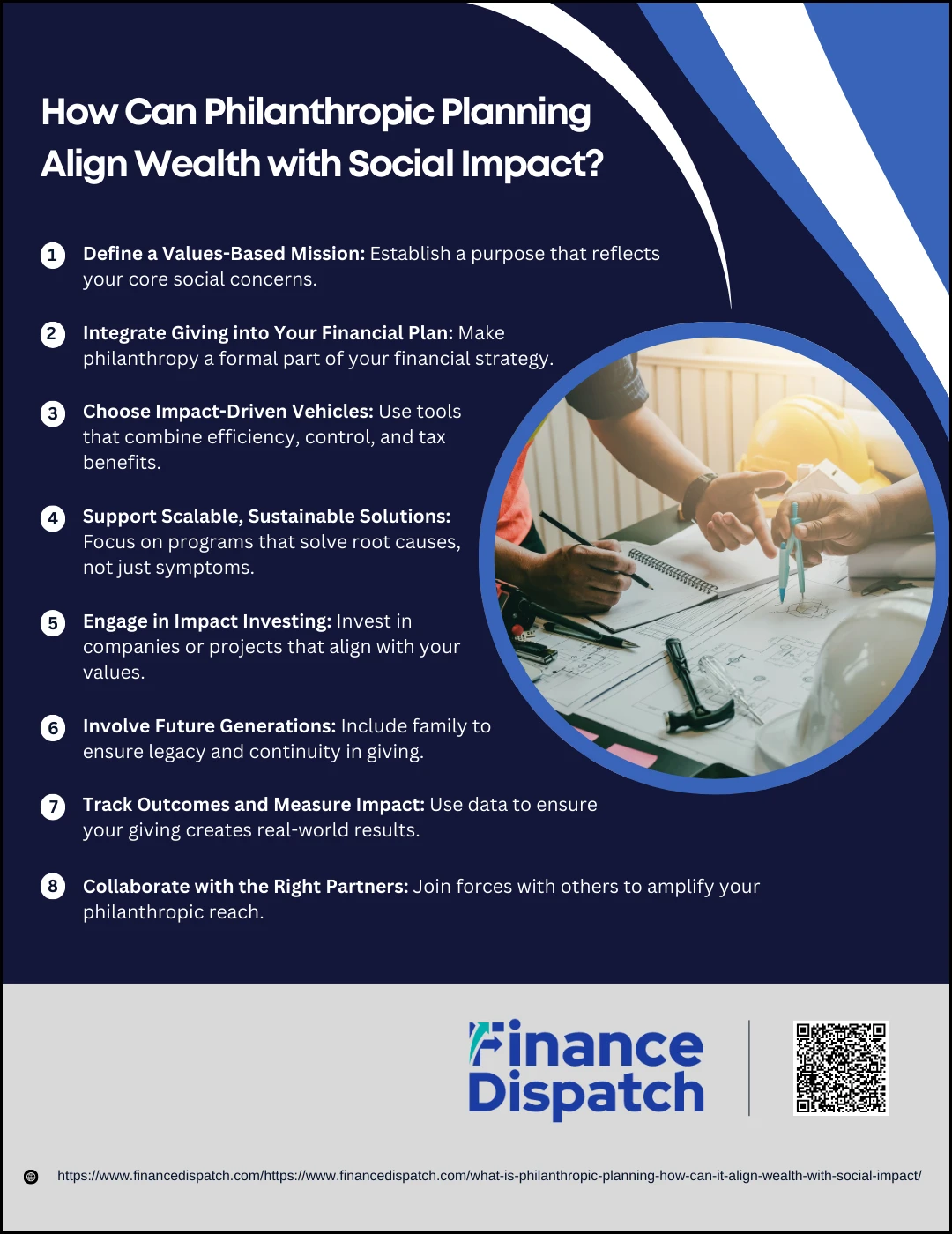 How Can Philanthropic Planning Align Wealth with Social Impact?
How Can Philanthropic Planning Align Wealth with Social Impact?
Philanthropic planning offers a transformative opportunity to use wealth not just for personal benefit, but as a catalyst for meaningful social change. When individuals and families take the time to thoughtfully align their financial strategies with their values, giving becomes more than an act of generosity—it becomes a form of leadership. Strategic philanthropic planning allows you to support causes you care about in ways that are intentional, measurable, and sustainable. It ensures that your resources—whether money, time, or expertise—create lasting value for society while reinforcing your own legacy and purpose. Here’s how this alignment is achieved step by step:
1. Define a Values-Based Mission
Identify what issues truly resonate with you or your family. These could include education reform, climate action, healthcare access, poverty reduction, or arts and culture. A clearly articulated mission helps filter opportunities, avoids scattered giving, and ensures every contribution has personal meaning and strategic purpose.
2. Integrate Giving into Your Financial Plan
True alignment begins when charitable giving becomes a formal part of your financial and estate planning—not just something you do at the end of the year. By working with wealth advisors, you can build a giving strategy that complements retirement goals, tax planning, investment growth, and intergenerational wealth transfer.
3. Choose Impact-Driven Vehicles
Select the right tools to channel your giving efficiently and effectively. Options like donor-advised funds offer flexibility and simplicity; private foundations provide control and legacy-building potential; charitable trusts combine financial return with long-term charitable support. These vehicles allow you to customize your impact while benefiting from tax advantages.
4. Support Scalable, Sustainable Solutions
Focus on high-impact programs or organizations that address root causes, not just symptoms. For example, rather than donating to short-term hunger relief alone, consider supporting initiatives that create local food systems, invest in small farmers, or improve access to job training. These approaches promote dignity, independence, and long-term results.
5. Engage in Impact Investing
Align your investment portfolio with your social values. Impact investing allows you to earn financial returns while funding ventures that improve lives—such as clean energy startups, affordable housing projects, or women-led businesses. This extends your impact beyond donations and turns everyday financial decisions into opportunities for change.
6. Involve Future Generations
Engage your children or successors in your philanthropic efforts. This not only ensures continuity of giving but also nurtures a family culture rooted in empathy, responsibility, and purpose. Involving younger generations in decision-making or board service can also bring fresh ideas and strengthen long-term commitment.
7. Track Outcomes and Measure Impact
Establish systems to evaluate the effectiveness of your giving. Use data, reports, and feedback to assess whether your support is making the intended difference. This step ensures accountability and helps you refine your approach to do even more good with the same resources.
8. Collaborate with the Right Partners
Philanthropy doesn’t have to be a solo effort. Partnering with nonprofits, community leaders, corporations, or fellow donors can significantly increase your reach and effectiveness. Strategic collaborations allow you to pool knowledge, share resources, and take on larger, more complex social issues.
Examples of Philanthropic Planning in Action
Philanthropic planning takes many forms, depending on personal values, financial goals, and desired impact. Here are some brief examples showing how individuals and organizations strategically use their wealth to make a difference:
- Donor-Advised Fund (DAF): A business owner sets up a DAF to support education initiatives over time while enjoying immediate tax benefits.
- Family Foundation: A family creates a private foundation focused on youth mental health, involving multiple generations in grantmaking.
- Charitable Remainder Trust: A couple donates appreciated assets, receives income for life, and supports cancer research after passing.
- Direct Giving + Volunteering: A retiree donates regularly to a food nonprofit and volunteers to help them grow sustainably.
- Impact Investing: An investor supports clean energy startups, earning returns while advancing environmental causes.
- Corporate Giving: A company funds scholarships and runs employee mentorship programs as part of its CSR strategy.
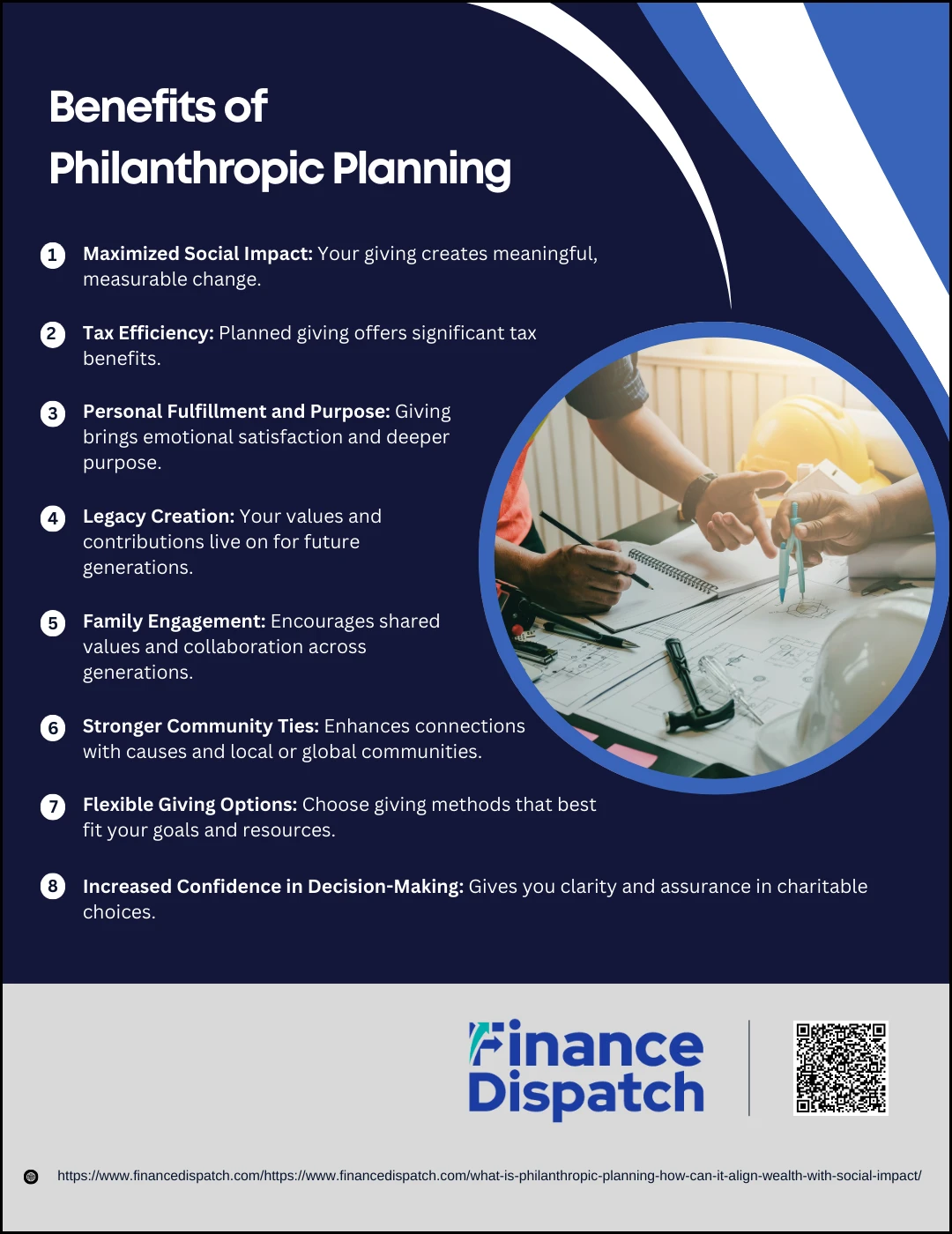 Benefits of Philanthropic Planning
Benefits of Philanthropic Planning
Philanthropic planning is more than a generous act—it’s a strategic approach that allows you to give intentionally, maximize the impact of your contributions, and create long-term value for both society and your own financial future. By aligning charitable giving with your personal values and financial goals, you not only support causes you care about but also strengthen your legacy, reduce tax burdens, and engage your family in meaningful conversations about wealth and responsibility. Here are some of the major benefits of incorporating philanthropic planning into your life:
1. Maximized Social Impact
With a clear strategy, your giving is targeted, thoughtful, and impactful. It supports high-impact organizations and long-term solutions rather than one-time relief, ensuring your contributions drive meaningful change.
2. Tax Efficiency
Philanthropic planning allows you to take advantage of various tax benefits, such as deductions for charitable contributions, avoiding capital gains taxes through asset donations, and reducing estate taxes through legacy planning tools like charitable trusts.
3. Personal Fulfillment and Purpose
Giving intentionally adds a sense of purpose and meaning to your financial journey. Knowing your resources are helping others or solving problems you deeply care about brings emotional satisfaction and a deeper connection to your wealth.
4. Legacy Creation
Strategic philanthropy ensures your values live on through future generations. Whether you establish a family foundation, scholarship fund, or a donor-advised fund, your giving can continue to make an impact well beyond your lifetime.
5. Family Engagement
Involving family members in philanthropic planning helps foster a culture of giving, encourages intergenerational collaboration, and strengthens family bonds around shared values and causes.
6. Stronger Community Ties
Supporting local or global causes through structured giving helps you connect with nonprofits, communities, and leaders. These relationships deepen your understanding of the issues and often lead to richer, more hands-on involvement.
7. Flexible Giving Options
Philanthropic planning gives you the flexibility to choose the most appropriate giving vehicles—whether it’s making direct donations, setting up a trust, or exploring impact investing—based on your financial goals and the level of control you desire.
8. Increased Confidence in Decision-Making
With a plan in place, you gain clarity and peace of mind. You’re less likely to feel overwhelmed by donation requests or trends, and more empowered to make decisions that align with your mission and values.
Common Misconceptions about Philanthropic Planning
Philanthropic planning is often misunderstood as something reserved only for the ultra-wealthy or those nearing retirement. In reality, it’s a versatile and valuable tool that can benefit anyone who wants to make a difference with their resources—regardless of income level or stage of life. These misconceptions can prevent people from engaging in impactful and rewarding giving. Let’s clear up some of the most common myths about philanthropic planning:
1. “Philanthropy is only for the rich.”
You don’t need to be a billionaire to make a difference. Philanthropic planning is scalable and can help individuals at all income levels give more effectively, even though modest donations or volunteering.
2. “It’s only about money.”
Philanthropy includes donating time, skills, and other resources—not just financial contributions. Volunteering or offering professional expertise can be just as valuable as cash donations.
3. “You need to give everything now.”
A good plan spreads giving over time. Whether it’s annual contributions, legacy giving, or multi-year commitments, you can design a strategy that fits your budget and life goals.
4. “Philanthropic planning is too complex.”
While there are advanced tools available, many giving strategies—like donor-advised funds or direct donations—are simple and easy to manage, especially with help from advisors.
5. “Philanthropy won’t benefit me.”
Besides personal fulfillment, philanthropic planning can offer tax advantages, strengthen family bonds, and even align with your broader financial planning goals.
6. “It’s just about writing checks.”
Strategic philanthropy is about making thoughtful decisions, choosing the right causes, measuring impact, and building a legacy—not just donating reactively.
7. “My contributions won’t make a difference.”
Every act of giving, no matter how small, has the potential to create positive ripple effects. When guided by a plan, even limited resources can drive meaningful change.
Conclusion
Philanthropic planning is a powerful way to align your wealth with your values and create a lasting, positive impact on the world around you. It transforms charitable giving from occasional acts into a meaningful, strategic journey—one that brings clarity, purpose, and long-term results. Whether you’re just beginning to explore giving or already supporting causes close to your heart, a well-designed plan helps ensure that your contributions are thoughtful, tax-efficient, and deeply fulfilling. By approaching philanthropy with intention, you not only strengthen communities and support critical issues but also build a legacy that reflects who you are and what you stand for.



